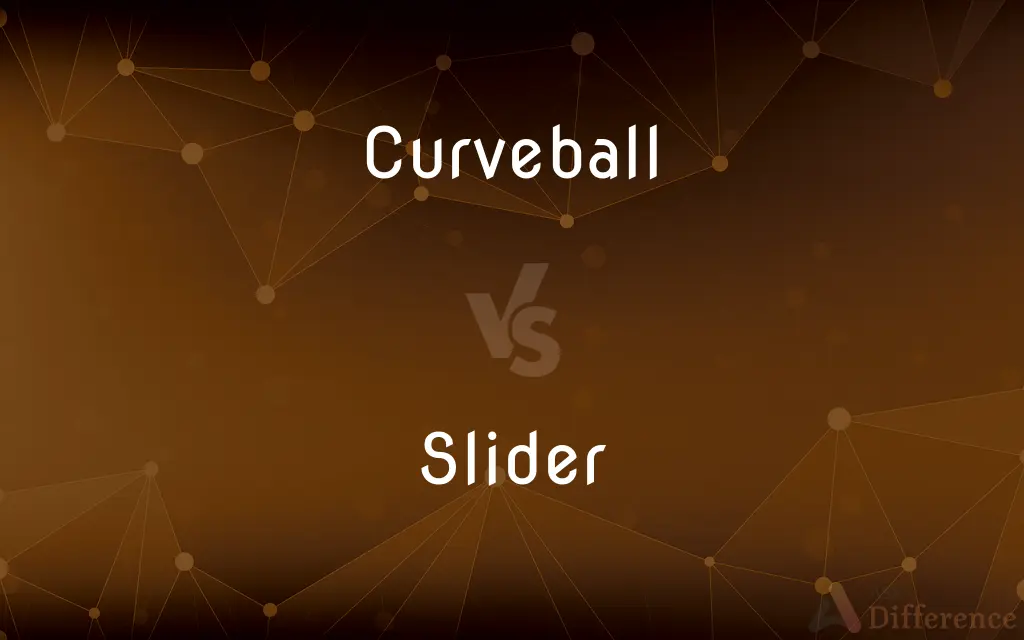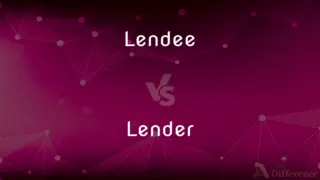Curveball vs. Slider — What's the Difference?
Edited by Tayyaba Rehman — By Fiza Rafique — Updated on November 6, 2023
A curveball is a pitch with a strong downward spin causing a vertical drop; a slider is thrown with a mix of sideways and downward spin, moving diagonally.

Difference Between Curveball and Slider
Table of Contents
ADVERTISEMENT
Key Differences
A curveball is a type of pitch in baseball known for its distinct downward movement which results from the pitcher's grip and wrist action, causing the ball to "curve" in the air. The curveball deceives batters by breaking sharply as it reaches home plate. In contrast, a slider is thrown with a different grip and wrist action, resulting in a combination of sideways and downward movement. This makes the slider faster than a curveball and it breaks later, creating a different challenge for the batter.
The speed of a curveball is typically slower than a fastball, ranging usually from 70 to 80 mph, which allows the ball to exhibit a more pronounced curve. The effectiveness of a curveball is in its break and the timing of that break in relation to the plate. On the other hand, a slider comes in faster than a curveball, with speeds often between 80 to 90 mph. The slider's late-breaking action can often look like a fastball to the batter before it veers off, making it a deceptive pitch.
Curveballs are known for their "12-6" drop, meaning the ball moves from the 12 o'clock position to the 6 o'clock position, referencing the hands of a clock. This pitch relies heavily on the gravitational pull on the ball and the spin imparted by the pitcher. Sliders, however, move more laterally and have a less vertical drop, often described as moving "across the table." This movement is due to the spin that causes the ball to slide away from a batter, hence the name.
Curveball pitchers use a grip where they place their fingers along or across the seams of the baseball, and upon release, impart a forward spin by snapping their wrists. The grip and wrist action are crucial in determining the effectiveness of the curveball's break. For the slider, the pitcher places their fingers off-center on the ball and imparts a spin that is less forward and more sideways compared to a curveball, resulting in the ball's distinct sliding action towards the batter.
Both the curveball and slider can be effective pitches in a baseball pitcher's arsenal and are used to outwit batters. The key difference in their effectiveness comes from the speed and the break. A batter expecting a fastball might be thrown off by the slower speed and greater arc of a curveball or the sharper, more sudden movement of a slider. Both pitches require skill and practice to master and can be used strategically to get batters out.
ADVERTISEMENT
Comparison Chart
Spin
Top-down, forward spin
Combination of sideways and downward spin
Movement
Sharp vertical drop
Diagonal movement with less drop
Speed
Slower (70-80 mph)
Faster (80-90 mph)
Break Timing
Breaks earlier, more pronounced arc
Breaks later, with a tighter trajectory
Grip
Fingers across or along the seams
Fingers off-center on the ball
Compare with Definitions
Curveball
A pitch that can be thrown with varying degrees of velocity and break.
He threw a slow curveball that tantalizingly dropped right before the plate.
Slider
Requires a grip off-center on the baseball to achieve its distinctive movement.
He gripped the ball for a slider, aiming to sneak it past the hitter.
Curveball
Often used by pitchers as a secondary pitch to the fastball.
Mixing a curveball with his fastballs, the pitcher kept hitters off-balance.
Slider
A pitch with a lateral and downward movement that can confuse batters.
The closer's slider was his go-to pitch for a game-ending strikeout.
Curveball
A pitch with a pronounced top-down spin that dives downward as it approaches the batter.
The pitcher's curveball fooled the batter, resulting in a swing and a miss.
Slider
Faster than a curveball and often appears to slide away from the batter.
The slider broke just outside the strike zone, making the batter swing wide.
Curveball
(Baseball) Any of several pitches that veer to the left when thrown with the right hand and to the right when thrown with the left hand.
Slider
A versatile pitch that can be tailored to move away from or towards a batter.
He threw a back-foot slider that the batter could not resist but miss.
Curveball
Can be an effective strikeout pitch due to its deceptive appearance.
With a full count, he delivered a curveball that caught the batter looking.
Slider
One that slides
The snowy hill was filled with young sliders.
Curveball
In baseball and softball, the curveball is a type of pitch thrown with a characteristic grip and hand movement that imparts forward spin to the ball, causing it to dive as it approaches the plate. Varieties of curveball include the 12–6 curveball, power curveball, and the knuckle curve.
Slider
(Baseball) A fast pitch released with the index and middle fingers close together and slightly off center so that it breaks in the same direction as a curve ball as it approaches the plate.
Curveball
(Slang) Something that is unexpected or designed to trick or deceive
That last question on the exam was a real curve ball.
Slider
A small hamburger served on a small bun, usually as a snack or appetizer.
Curveball
(baseball) A forespin pitch thrown by rotating the index and middle fingers down and resulting in motion down "curve"
He bit on a curveball in the dirt.
Slider
Any of various turtles of the genus Trachemys, especially T. scripta subsp. elegans of North America, having a red stripe behind the eye and often kept as a pet.
Curveball
An unexpected turn of events initiated by an opponent or chance; an exception or outlier.
Life has thrown him a few curveballs.
Slider
Agent noun of slide: one who slides.
Curveball
(baseball) To throw a curveball.
Slider
A sliding door.
Curveball
Known for its dramatic movement, sometimes referred to as a "12-6" curve.
The rookie was stunned by the veteran's sharp 12-6 curveball.
Slider
(baseball) A pitch thrown with added pressure by middle and ring fingers yielding a combination of backspin and sidespin, resulting in a motion to the left when thrown by a right handed pitcher.
The closer had a wicked slider that was almost unhittable.
Slider
(cricket) A similar delivery in which the wrist and ring finger work to impart backspin to the ball.
Slider
A small hamburger.
We ordered five sliders.
Slider
(curling) A piece of Teflon or similar material attached to a curling shoe that allows the player to slide along the ice.
Slider
The movable part of a zip fastener that opens or closes the row of teeth.
Slider
(GUI) A widget allowing the user to select a value or position on a sliding scale.
Slider
A slideshow on a web page.
Slider
The red-bellied terrapin (Pseudemys rubriventris, syn. Pseudemys rugosa).
Slider
(skydiving) A rectangle of fabric that helps produce an orderly parachute deployment.
Slider
Synonym of slide
Slider
An open-toed and backless sandal
Slider
See Slidder.
Slider
One who, or that which, slides; especially, a sliding part of an instrument or machine.
Slider
The red-bellied terrapin (Pseudemys rugosa).
Slider
Any of several North American freshwater turtles of the genus Chrysemis; some, such as C. scripta are sold commercially as pets.
Slider
A fast pitch that breaks slightly just in front of the batter, in the same direction as a curve ball (i. e. , away from the side from which it was thrown).
Slider
A person who slips or slides because of loss of traction
Slider
Someone who races the luge
Slider
Freshwater turtle of United States and South America; frequently raised commercially; some young sold as pets
Slider
A fastball that curves slightly away from the side from which it was thrown
Slider
It's a common pitch in a pitcher's repertoire due to its effectiveness.
The pitcher added a slider to his repertoire, and his strikeout rate increased.
Common Curiosities
What's a curveball in baseball?
A pitch with a significant downward spin and vertical movement.
How does a slider's spin affect its trajectory?
It causes the ball to slide laterally with a slight downward angle.
Is it harder to control a curveball or a slider?
Both require great control, but a curveball can be more difficult due to the larger break.
Which is harder to hit, a curveball or slider?
Both can be difficult; it often depends on the pitcher's skill and the batter's weaknesses.
What type of spin results in a curveball?
A forward, top-down spin.
Are curveballs used more often in certain counts?
They are often used in strikeout situations or to catch batters off guard.
What's the average speed of a curveball?
Usually between 70-80 mph.
How is a slider thrown differently from a curveball?
A slider is thrown with more lateral spin and moves diagonally down.
Is a slider faster than a curveball?
Yes, a slider is generally thrown faster, around 80-90 mph.
Do batters have to adjust differently for a curveball vs. a slider?
Yes, timing and point of contact vary due to the different movements of the pitches.
Why might a pitcher choose a slider over a curveball?
A slider can be more deceptive due to its speed and break pattern.
Can all pitchers throw both a curveball and slider?
Not all; it depends on their skill set and what they are comfortable with.
What grip is used for a curveball?
Fingers along or across the seams with a snapping wrist motion.
What grip is used for a slider?
Fingers off-center, imparting lateral and downward spin.
Can a slider be mistaken for a fastball?
Yes, due to its speed and late break.
Share Your Discovery

Previous Comparison
Century vs. Decade
Next Comparison
Lendee vs. LenderAuthor Spotlight
Written by
Fiza RafiqueFiza Rafique is a skilled content writer at AskDifference.com, where she meticulously refines and enhances written pieces. Drawing from her vast editorial expertise, Fiza ensures clarity, accuracy, and precision in every article. Passionate about language, she continually seeks to elevate the quality of content for readers worldwide.
Edited by
Tayyaba RehmanTayyaba Rehman is a distinguished writer, currently serving as a primary contributor to askdifference.com. As a researcher in semantics and etymology, Tayyaba's passion for the complexity of languages and their distinctions has found a perfect home on the platform. Tayyaba delves into the intricacies of language, distinguishing between commonly confused words and phrases, thereby providing clarity for readers worldwide.















































